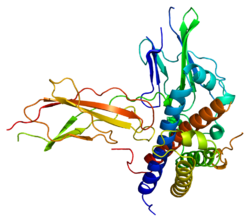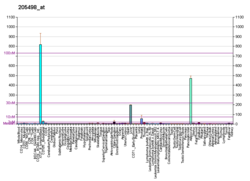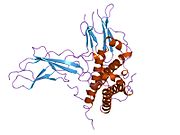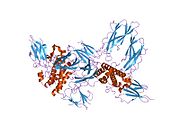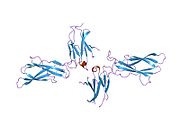Growth hormone receptor is a protein that in humans is encoded by the GHR gene. GHR orthologs have been identified in most mammals.
Structure
Growth hormone receptor (GHR) is a transmembrane protein consisting of 620 amino acids. The receptor is part of the Type I cytokine receptor family of receptors. GHR exists in two forms as a full length membrane-bound receptor and as a soluble GH binding protein (GHBP). GHR contains two fibronectin type III β domains in its extracellular domain, whereas the intracellular domain contains tyrosine Kinase JAK2 binding sites for SH2 proteins. JAK2 is the primary signal transducer for growth hormone.
Function
This gene encodes a protein that is a transmembrane receptor for growth hormone. Binding of growth hormone to the receptor leads to reorientation of a pre-assembled receptor dimer dimerization (the receptor may however also exist as monomers on the cell surface ) and the activation of an intra- and intercellular signal transduction pathway leading to growth. A common alternate allele of this gene, called GHRd3, lacks exon three and has been well characterized. Mutations in this gene have been associated with Laron syndrome, also known as the growth hormone insensitivity syndrome (GHIS), a disorder characterized by short stature (proportional dwarfism). Other splice variants, including one encoding a soluble form of the protein (GHRtr), have been observed but have not been thoroughly characterized. Laron mice (that is mice genetically engineered to carry defective Ghr), have a dramatic reduction in body mass (only reaching 50% of the weight of normal siblings), and also show a ~40% increase in lifespan.

Interactions
Growth hormone receptor has been shown to interact with SGTA, PTPN11, Janus kinase 2, Suppressor of cytokine signaling 1 and CISH.
Evolution
The GHR gene is used in animals as a nuclear DNA phylogenetic marker. The exon 10 has first been experienced to explore the phylogeny of the major groups of Rodentia. GHR has also proven useful at lower taxonomic levels, e.g., in octodontoid, arvicoline, muroid, murine, and peromyscine rodents, in arctoid and felid carnivores, and in dermopterans. Note that the GHR intron 9 has also been used to investigate the mustelid and hyaenid carnivores phylogenetics.
Antagonists
Growth hormone receptor antagonists such as pegvisomant (trade name Somavert) are used in the treatment of acromegaly. They are used if the tumor of the pituitary gland causing the acromegaly cannot be controlled with surgery or radiation, and the use of somatostatin analogues is unsuccessful. Pegvisomant is delivered as a powder that is mixed with water and injected under the skin.
See also
References
- ^ GRCh38: Ensembl release 89: ENSG00000112964 – Ensembl, May 2017
- ^ GRCm38: Ensembl release 89: ENSMUSG00000055737 – Ensembl, May 2017
- "Human PubMed Reference:". National Center for Biotechnology Information, U.S. National Library of Medicine.
- "Mouse PubMed Reference:". National Center for Biotechnology Information, U.S. National Library of Medicine.
- ^ "Entrez Gene: GHR growth hormone receptor".
- ^ "OrthoMaM phylogenetic marker: GHR coding sequence". Archived from the original on 2015-09-24. Retrieved 2009-11-18.
- Leung DW, Spencer SA, Cachianes G, Hammonds RG, Collins C, Henzel WJ, Barnard R, Waters MJ, Wood WI (1987). "Growth hormone receptor and serum binding protein: purification, cloning and expression". Nature. 330 (6148): 537–43. Bibcode:1987Natur.330..537L. doi:10.1038/330537a0. PMID 2825030. S2CID 4370204.
- Postel-Vinay MC, Finidori J (December 1995). "Growth hormone receptor: structure and signal transduction". European Journal of Endocrinology. 133 (6): 654–9. doi:10.1530/eje.0.1330654. PMID 8548048.
- Brooks AJ, Wooh JW, Tunny KA, Waters MJ (2008-01-01). "Growth hormone receptor; mechanism of action". The International Journal of Biochemistry & Cell Biology. 40 (10): 1984–9. doi:10.1016/j.biocel.2007.07.008. PMID 17888716.
- Dehkhoda F, Lee CM, Medina J, Brooks AJ (13 February 2018). "The Growth Hormone Receptor: Mechanism of Receptor Activation, Cell Signaling, and Physiological Aspects". Frontiers in Endocrinology. 9: 35. doi:10.3389/fendo.2018.00035. PMC 5816795. PMID 29487568.
- Brooks AJ, Waters MJ (September 2010). "The growth hormone receptor: mechanism of activation and clinical implications". Nature Reviews. Endocrinology. 6 (9): 515–25. doi:10.1038/nrendo.2010.123. PMID 20664532. S2CID 23639819.
- González L, Curto LM, Miquet JG, Bartke A, Turyn D, Sotelo AI (April 2007). "Differential regulation of membrane associated-growth hormone binding protein (MA-GHBP) and growth hormone receptor (GHR) expression by growth hormone (GH) in mouse liver". Growth Hormone & IGF Research. 17 (2): 104–12. doi:10.1016/j.ghir.2006.12.002. PMID 17321774.
- Brooks AJ, Dai W, O'Mara ML, Abankwa D, Chhabra Y, Pelekanos RA, Gardon O, Tunny KA, Blucher KM, Morton CJ, Parker MW, Sierecki E, Gambin Y, Gomez GA, Alexandrov K, Wilson IA, Doxastakis M, Mark AE, Waters MJ (May 2014). "Mechanism of activation of protein kinase JAK2 by the growth hormone receptor". Science. 344 (6185): 1249783. doi:10.1126/science.1249783. PMID 24833397. S2CID 27946074.
- ^ Fabre PH, Upham NS, Emmons LH, Justy F, Leite YL, Carolina Loss A, Orlando L, Tilak MK, Patterson BD, Douzery EJ (March 2017). "Mitogenomic Phylogeny, Diversification, and Biogeography of South American Spiny Rats" (PDF). Molecular Biology and Evolution. 34 (3): 613–633. doi:10.1093/molbev/msw261. PMID 28025278.
- Schantl JA, Roza M, De Jong AP, Strous GJ (August 2003). "Small glutamine-rich tetratricopeptide repeat-containing protein (SGT) interacts with the ubiquitin-dependent endocytosis (UbE) motif of the growth hormone receptor". The Biochemical Journal. 373 (Pt 3): 855–63. doi:10.1042/BJ20021591. PMC 1223544. PMID 12735788.
- Stofega MR, Herrington J, Billestrup N, Carter-Su C (September 2000). "Mutation of the SHP-2 binding site in growth hormone (GH) receptor prolongs GH-promoted tyrosyl phosphorylation of GH receptor, JAK2, and STAT5B". Molecular Endocrinology. 14 (9): 1338–50. doi:10.1210/mend.14.9.0513. PMID 10976913.
- Moutoussamy S, Renaudie F, Lago F, Kelly PA, Finidori J (June 1998). "Grb10 identified as a potential regulator of growth hormone (GH) signaling by cloning of GH receptor target proteins". The Journal of Biological Chemistry. 273 (26): 15906–12. doi:10.1074/jbc.273.26.15906. PMID 9632636.
- Frank SJ, Yi W, Zhao Y, Goldsmith JF, Gilliland G, Jiang J, Sakai I, Kraft AS (June 1995). "Regions of the JAK2 tyrosine kinase required for coupling to the growth hormone receptor". The Journal of Biological Chemistry. 270 (24): 14776–85. doi:10.1074/jbc.270.24.14776. PMID 7540178.
- VanderKuur JA, Wang X, Zhang L, Campbell GS, Allevato G, Billestrup N, Norstedt G, Carter-Su C (August 1994). "Domains of the growth hormone receptor required for association and activation of JAK2 tyrosine kinase". The Journal of Biological Chemistry. 269 (34): 21709–17. doi:10.1016/S0021-9258(17)31863-X. PMID 8063815.
- Hellgren G, Jansson JO, Carlsson LM, Carlsson B (June 1999). "The growth hormone receptor associates with Jak1, Jak2 and Tyk2 in human liver". Growth Hormone & IGF Research. 9 (3): 212–8. doi:10.1054/ghir.1999.0111. PMID 10502458.
- ^ Ram PA, Waxman DJ (December 1999). "SOCS/CIS protein inhibition of growth hormone-stimulated STAT5 signaling by multiple mechanisms". The Journal of Biological Chemistry. 274 (50): 35553–61. doi:10.1074/jbc.274.50.35553. PMID 10585430.
- Adkins RM, Gelke EL, Rowe D, Honeycutt RL (May 2001). "Molecular phylogeny and divergence time estimates for major rodent groups: evidence from multiple genes". Molecular Biology and Evolution. 18 (5): 777–91. doi:10.1093/oxfordjournals.molbev.a003860. PMID 11319262.
- Adkins RM, Walton AH, Honeycutt RL (March 2003). "Higher-level systematics of rodents and divergence time estimates based on two congruent nuclear genes". Molecular Phylogenetics and Evolution. 26 (3): 409–20. doi:10.1016/S1055-7903(02)00304-4. PMID 12644400.
- Blanga-Kanfi S, Miranda H, Penn O, Pupko T, DeBry RW, Huchon D (April 2009). "Rodent phylogeny revised: analysis of six nuclear genes from all major rodent clades". BMC Evolutionary Biology. 9 (1): 71. Bibcode:2009BMCEE...9...71B. doi:10.1186/1471-2148-9-71. PMC 2674048. PMID 19341461.
- Honeycutt RL, Rowe DL, Gallardo MH (March 2003). "Molecular systematics of the South American caviomorph rodents: relationships among species and genera in the family Octodontidae". Molecular Phylogenetics and Evolution. 26 (3): 476–89. doi:10.1016/S1055-7903(02)00368-8. hdl:10533/174195. PMID 12644405.
- Galewski T, Tilak MK, Sanchez S, Chevret P, Paradis E, Douzery EJ (October 2006). "The evolutionary radiation of Arvicolinae rodents (voles and lemmings): relative contribution of nuclear and mitochondrial DNA phylogenies". BMC Evolutionary Biology. 6: 80. doi:10.1186/1471-2148-6-80. PMC 1618403. PMID 17029633.
- Steppan S, Adkins R, Anderson J (August 2004). "Phylogeny and divergence-date estimates of rapid radiations in muroid rodents based on multiple nuclear genes". Systematic Biology. 53 (4): 533–53. doi:10.1080/10635150490468701. PMID 15371245.
- Rowe KC, Reno ML, Richmond DM, Adkins RM, Steppan SJ (April 2008). "Pliocene colonization and adaptive radiations in Australia and New Guinea (Sahul): multilocus systematics of the old endemic rodents (Muroidea: Murinae)". Molecular Phylogenetics and Evolution. 47 (1): 84–101. doi:10.1016/j.ympev.2008.01.001. PMID 18313945.
- Lecompte E, Aplin K, Denys C, Catzeflis F, Chades M, Chevret P (July 2008). "Phylogeny and biogeography of African Murinae based on mitochondrial and nuclear gene sequences, with a new tribal classification of the subfamily". BMC Evolutionary Biology. 8 (1): 199. Bibcode:2008BMCEE...8..199L. doi:10.1186/1471-2148-8-199. PMC 2490707. PMID 18616808.
- Miller J. R., Engstrom M. D. (2008). "The relationships of major lineages within peromyscine rodents: a molecular phylogenetic hypothesis and systematic reappraisal". J. Mammal. 89 (5): 1279–1295. doi:10.1644/07-MAMM-A-195.1.
- Fulton TL, Strobeck C (October 2006). "Molecular phylogeny of the Arctoidea (Carnivora): effect of missing data on supertree and supermatrix analyses of multiple gene data sets". Molecular Phylogenetics and Evolution. 41 (1): 165–81. doi:10.1016/j.ympev.2006.05.025. PMID 16814570.
- Johnson WE, Eizirik E, Pecon-Slattery J, Murphy WJ, Antunes A, Teeling E, O'Brien SJ (January 2006). "The late Miocene radiation of modern Felidae: a genetic assessment". Science. 311 (5757): 73–7. Bibcode:2006Sci...311...73J. doi:10.1126/science.1122277. PMID 16400146. S2CID 41672825.
- Janecka JE, Helgen KM, Lim NT, Baba M, Izawa M, Murphy WJ (November 2008). "Evidence for multiple species of Sunda colugo". Current Biology. 18 (21): R1001-2. Bibcode:2008CBio...18R1001J. doi:10.1016/j.cub.2008.09.005. PMID 19000793. S2CID 14945429.
- Koepfli KP, Wayne RK (October 2003). "Type I STS markers are more informative than cytochrome B in phylogenetic reconstruction of the Mustelidae (Mammalia: Carnivora)". Systematic Biology. 52 (5): 571–93. doi:10.1080/10635150390235368. PMID 14530127.
- Koepfli KP, Jenks SM, Eizirik E, Zahirpour T, Van Valkenburgh B, Wayne RK (March 2006). "Molecular systematics of the Hyaenidae: relationships of a relictual lineage resolved by a molecular supermatrix". Molecular Phylogenetics and Evolution. 38 (3): 603–20. doi:10.1016/j.ympev.2005.10.017. PMID 16503281.
- Schreiber I, Buchfelder M, Droste M, Forssmann K, Mann K, Saller B, Strasburger CJ (January 2007). "Treatment of acromegaly with the GH receptor antagonist pegvisomant in clinical practice: safety and efficacy evaluation from the German Pegvisomant Observational Study". European Journal of Endocrinology. 156 (1): 75–82. doi:10.1530/eje.1.02312. PMID 17218728. S2CID 12121175.
- "Scientific Discussion of Somavert" (PDF). European Medicines Agency. 2004. Archived from the original (PDF) on 2018-06-18. Retrieved 2011-04-29.
External links
- Somatotropin+receptors at the U.S. National Library of Medicine Medical Subject Headings (MeSH)
- Illustration at nih.gov
- Overview
- Growth Hormone Receptor Archived 2015-10-16 at the Wayback Machine: Molecule of the Month by Shuchismita Dutta and David Goodsell (April 2004)
- PDBe-KB provides an overview of all the structure information available in the PDB for Human Growth hormone receptor
| Neuropeptide receptors | |||||||||||||
|---|---|---|---|---|---|---|---|---|---|---|---|---|---|
| G protein-coupled receptor |
| ||||||||||||
| Type I cytokine receptor | |||||||||||||
| Enzyme-linked receptor | |||||||||||||
| Other | |||||||||||||
| Cytokine receptors | |||||||||||||||
|---|---|---|---|---|---|---|---|---|---|---|---|---|---|---|---|
| Chemokine receptor (GPCRs) |
| ||||||||||||||
| TNF receptor |
| ||||||||||||||
| JAK-STAT |
| ||||||||||||||
| Ig superfamily | |||||||||||||||
| IL 17 family | |||||||||||||||
| Enzyme-linked receptor | |||||||||||||||
| GH/IGF-1 axis signaling modulators | |
|---|---|
| GH (somatotropin) |
|
| GHIH (somatostatin) |
|
| GHRH (somatocrinin) |
|
| GHS (ghrelin) |
|
| IGF-1 (somatomedin) |
|
| PDB gallery | |
|---|---|
|
